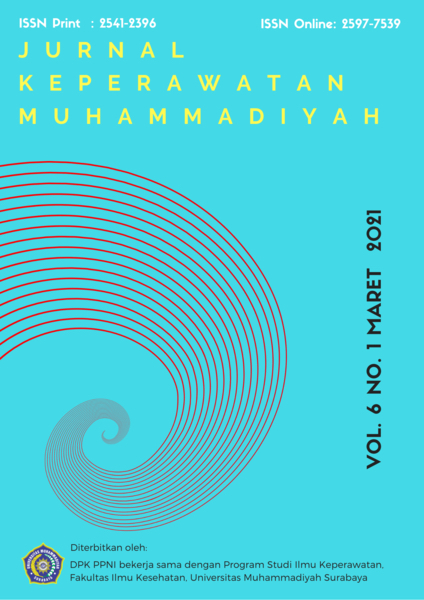Pengetahuan Perawatan Nifas pada Masyarakat yang Terdampak Rob di Pekalongan
DOI:
https://doi.org/10.30651/jkm.v6i1.7131Keywords:
Knowledge, Postpartum Care, Tidal floodAbstract
Objective: Â Â The puerperium is the process of returning the reproductive organs to their pre-pregnancy state that requires special care. Good care is supported by good environmental conditions. The environmental situation in the affected areas has hampered sanitation and daily activities because houses have been submerged in water for a long time.This study aims to determine the knowledge of postpartum care in affected communities, especially in the area of Karangjompo village, Pekalongan Regency
Methods: This article  is a descriptive study, a sample of 85 respondents postartum mother in Karangjompo Village was taken by total sampling.
Results: Â Â Knowledge of postpartum care for the affected community tidal flood in Karangjompo village is good (49.4%). However, there are still postpartum care criteria, most of which are still lacking, namely the fulfillment of sexual needs (77.6%) and the selection and use of postpartum contraceptives (67.1%).Conclusion:Â Â Â There is a need for cross-sector collaboration to address various health problems, especially in maternal and child health in areas affected by tidal waves. There is a need for specific guidelines on postpartum care for people affected by rob by taking into account the material and socio-cultural aspects of the local community.References
Dharma, K. (2011). Metodologi Penelitian Keperawatan. Trans Info Media.
Dibari, J. N., Yu, S. M., Chao, S. M., & Lu, M. C. (2014). Use of postpartum care: Predictors and barriers. Journal of Pregnancy, 2014. https://doi.org/10.1155/2014/530769
Hanafiah, T. M. (2008). Perawatan Masa Nifas. In USU digita library (pp. 1–3).
Islamy, N., Rudiyanto, W., Hanriko, R., & Hamidi, S. (2018). Analisis Masalah dan Rekomendasi Dalam Pembiayaan Pelayanan Keluarga Berencana Pasca Persalinan Metode Kontrasepsi Jangka Panjang ( MKJP ) di Rumah Sakit Pemerintah dan Swasta. Jurnal Pengabdian Masyarakat Ruwa Jurnal, 98–100.
Kim, Y., & Dee, V. (2017). Self-Care for Health in Rural Hispanic Women at Risk for Postpartum Depression. Maternal and Child Health Journal, 21(1), 77–84. https://doi.org/10.1007/s10995-016-2096-8
Makins, A., & Cameron, S. (2020). Post pregnancy contraception. Best Practice and Research: Clinical Obstetrics and Gynaecology, 66, 41–54. https://doi.org/10.1016/j.bpobgyn.2020.01.004
Mostafa, W., Gamel, A., Sarhan, A., Genedy, E., & Hassan, H. E. (2020). Impact of Puerperal Sepsis Self-Care Nursing Guideline on Women ’ s Knowledge and Practices. American Journal of Nursing Research, 8(2), 132–141. https://doi.org/10.12691/ajnr-8-2-1
Pratomo, A. J. (2008). Analisis Kerentanan Banjir di Daerah Aliran Sungai Sengkarang Kabupaten Pekalongan Provinsi Jawa Tengah dengan Bantuan Sistem Informasi Geografis. Universitas Muhammadiyah Surakarta.
Purifyningtyas, H. Q., & Wijaya, H. B. (2016). Kajian Kapasitas Adaptasi Masyarakat Pesisir Pekalongan terhadap Kerentanan Banjir Rob. 4, 81–94. https://doi.org/10.14710/jwl.4.2.81-94
Ramadhanni, R. F. (2015). Implementasi Program Penanganan Banjir Rob di Wilayah Pesisir Kota Pekalongan. Journal of Politic and Government Studies, V(4).
Rudiarto, I., Rengganis, H., Sarasadi, A., & Caesar, E. (2020). The Effectiveness of Strategy Adaptations on Tidal Flood in the Coastal Areas of Sayung, Demak, Central Java, Indonesia. IOP Conference Series: Earth and Environmental Science, 448(1). https://doi.org/10.1088/1755-1315/448/1/012090
Sabola, N. E., Shahin, M. A., Khader, K. A., Metwally, H. M., & Desoky, M. M. (2020). Sexual Nursing Care for the Postpartum Period and Its Impact on Sexual Dysfunction and Life Satisfaction Among Egyptian Women. Malaysian Journal of Public Health Medicine, 20(2), 108–115. https://doi.org/10.37268/mjphm/vol.20/no.2/art.491
Sacks, E., & Langlois, É. V. (2016). Postnatal care: Increasing coverage, equity, and quality. The Lancet Global Health, 4(7), e442–e443. https://doi.org/10.1016/S2214-109X(16)30092-4
Sari, D. P., Brahmana, I. B., Inayati, I., & ... (2020). Tingkat Kepuasan Pemasangan Dan Kendala Pemakaian Pengguna Kb Iud Pasca Salin. Jurnal Keperawatan Dan Kesehatan Masyarakat, 9(2), 120–125. http://jurnal.stikescendekiautamakudus.ac.id/index.php/stikes/article/view/592
Tran, N. T., Seuc, A., Tshikaya, B., Mutuale, M.,
Landoulsi, S., Kini, B., Mbu Nkolomonyi, B., Nyandwe Kyloka, J., Langwana, F., Cuzin-Kihl, A., Kiarie, J., Gaffield, M. E., Yodi, R., & Mashinda Kulimba, D. (2020). Effectiveness of post-partum family planning interventions on contraceptive use and method mix at 1 year after childbirth in Kinshasa, DR Congo (Yam Daabo): a single-blind, cluster-randomised controlled trial. The Lancet Global Health, 8(3), e399–e410. https://doi.org/10.1016/S2214-109X(19)30546-7
Downloads
Published
Issue
Section
License
- Penulis tetap memegang hak atas karyanya dan memberikan hak publikasi pertama kepada jurnal ini yang secara simultan karya tersebut dilisensikan di bawah:Â Creative Commons Attribution-ShareAlike 4.0 International (CC BY-SA 4.0)













